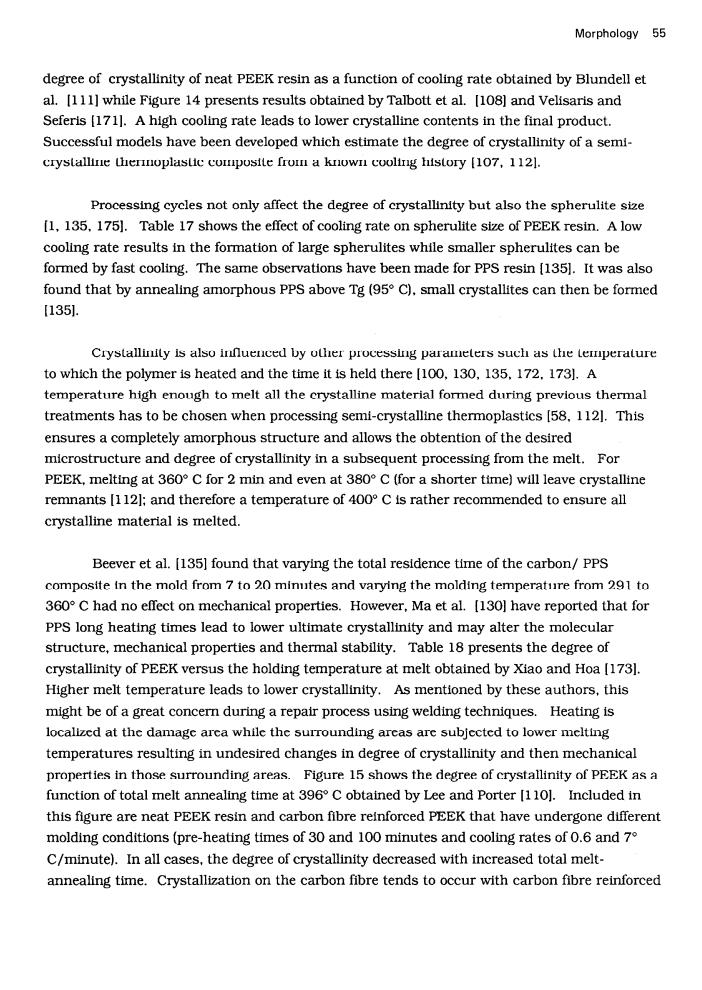正在加载图片...

Morphology 55 degree of crystallinity of neat PEEK resin as a function of cooling rate obtained by Blundell et al.[111]while Figure 14 presents results obtained by Talbott et al.[108]and Velisaris and Seferis [1711.A high cooling rate leads to lower crystalline contents in the final product. Successful models have been developed which estimate the degree of crystallinity of a semi- crystalliue thernoplasuc composite from a known cooling history [107,112]. Processing cycles not only affect the degree of crystallinity but also the spherulite size [1,135.175].Table 17 shows the effect of cooling rate on spherulite size of PEEK resin.A low cooling rate results in the formation of large spherulites while smaller spherulites can be formed by fast cooling.The same observations have been made for PPS resin (135].It was also found that by annealing amorphous PPS above Tg(95 C).small crystallites can then be formed [1351. Crystallinity is also influenced by other processing parameters such as the lemperature to which the polymer is heated and the time it is held there [100,130,135,172.173].A temperature high enough to melt all the crystalline material formed during previous thermal treatments has to be chosen when processing semi-crystalline thermoplastics [58.1121.This ensures a completely amorphous structure and allows the obtention of the desired microstructure and degree of crystallinity in a subsequent processing from the melt.For PEEK,melting at 360C for 2 min and even at 380 C (for a shorter time)will leave crystalline remnants [112];and therefore a temperature of 400 C is rather recommended to ensure all crystalline material is melted. Beever et al.[135]found that varying the total residence time of the carbon/PPS composite in the mold from 7 to 20 minutes and varying the molding temperature from 291 to 360C had no effect on mechanical properties.However,Ma et al.[130]have reported that for PPS long heating times lead to lower ultimate crystallinity and may alter the molecular structure,mechanical properties and thermal stability.Table 18 presents the degree of crystallinity of PEEK versus the holding temperature at melt obtained by Xiao and Hoa [1731. Higher melt temperature leads to lower crystallinity.As mentioned by these authors,this might be of a great concern during a repair process using welding techniques.Heating is localized at the damagc arca while the surrounding arcas are subjected to lower melting temperatures resulting in undesired changes in degree of crystallinity and then mechanical properties in those surrounding areas.Figure 15 shows the degree of crystallinity of PEEK as a function of total melt annealing time at 396C obtained by Lee and Porter [110].Included in this figure are neat PEEK resin and carbon fibre relnforced PEEK that have undergone different molding conditions (pre-heating times of 30 and 100 minutes and cooling rates of 0.6 and 7 C/minute).In all cases,the degree of crystallinity decreased with increased total melt- annealing time.Crystallization on the carbon fibre tends to occur with carbon fibre reinforcedMorphology 55 degree of crystallinity of neat PEEK resin as a function of cooling rate obtained by Blundell et al. [ 11 l] while Figure 14 presents results obtained by Talbott et al. [ 1081 and Velisaris and Seferis (17 11. A high cooling rate leads to lower crystalline contents in the final product. Successful models have been developed which estimate the degree of crystallinity of a semicrystalline thermoplastic composite from a known cooling history (107, 1121. Processing cycles not only affect the degree of crystallinity but also the spherulite size 11, 135, 1751. Table 17 shows the effect of cooling rate on spherulite size of PEEK resin. A low cooling rate results in the formation of large spherulites while smaller spherulites can be formed by fast cooling. The same observations have been made for PPS resin [ 1351. It was also found that by annealing amorphous PPS above Tg (95” C], small crystallites can then be formed [135]. Crystallinity is also influenced by other processing parameters such as the temperature to which the polymer is heated and the time it is held there IlOO, 130, 135. 172. 1731. A temperature high enough to melt all the crystalline material formed during previous thermal treatments has to be chosen when processing semi-crystalline thermoplastics [58, 1121. This ensures a completely amorphous structure and allows the obtention of the desired microstructure and degree of crystallinity in a subsequent processing from the melt. For PEEK, melting at 360” C for 2 min and even at 380” C (for a shorter time) will leave crystalline remnants [112]: and therefore a temperature of 400” C is rather recommended to ensure all crystalline material is melted. Beever et al. [ 1351 found that varying the total residence time of the carbon/ PPS composite in the mold from 7 to 20 minutes and varying the molding temperature from 291 to 360” C had no effect on mechanical properties. However, Ma et al. [ 1301 have reported that for PPS long heating times lead to lower ultimate crystallinity and may alter the molecular structure, mechanical properties and thermal stability. Table 18 presents the degree of crystallinity of PEEK versus the holding temperature at melt obtained by Xiao and Hoa [ 1731. Higher melt temperature leads to lower crystallinity. As mentioned by these authors, this might be of a great concern during a repair process using welding techniques. Heating is localized at the damage area while the surrounding areas are subjected to lower melting temperatures resulting in undesired changes in degree of crystallinity and then mechanical properties in those surrounding areas. Figure 15 shows the degree of crystallinity of PEEK as a function of total melt annealing time at 396” C obtained by Lee and Porter [ 1 lo]. Included in this figure are neat PEEK resin and carbon fibre reinforced PEEK that have undergone different molding conditions (pre-heating times of 30 and 100 minutes and cooling rates of 0.6 and 7’ C/minute). In all cases, the degree of crystallinity decreased with increased total meltannealing time. Crystallization on the carbon fibre tends to occur with carbon fibre reinforced